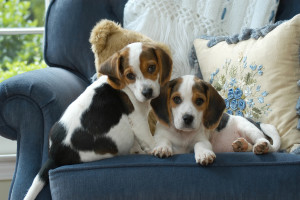
American author Gene Hill once said, “Whoever said you can’t buy happiness forgot little puppies.†If you’ve ever enjoyed inhaling puppy breath while being licked in the face by a wriggling bundle of fur then you understand this statement firsthand.
Getting off on the right paw with your new pet is important. You want to shower it with love and affection so that it will provide you with a lifetime of loyalty. But without properly preparing, instead of a dream dog you could be on the road to a doggone difficult situation.
Perhaps you are reading this article because you are planning to get a new dog, or because you just recently added a new dog to your home. Either way, what an exhilarating time for your family! Everyone is excited and wants to pitch in to help, right?
Use These Tips for Success
As the head of household, it’s your job to take ahold of your family’s momentum and direct its energy into the following tasks. These tasks will help provide your puppy with a seamless transition from littermates to human pack family.
1. SUPPLIES – You will need more than a plaid raincoat and rhinestone-studded collar for your pet. Metal or ceramic water bowls, a non-retractable leash, an ID tag, and a crate are all essential items. You will also want to use the same brand of dog food, and if you must switch then make a gradual transition.
2. RESPONSIBILITY – Since everyone in the family is so eager to help out, now is the perfect time to divvy up the chores with an official family chore chart. You can even use the chart as an incentive to reward younger family members who are old enough to receive an allowance.
3. RULES – The new puppy isn’t the only one who will need some ground rules. Make sure your family knows whether or not the puppy is allowed on the furniture. Dogs and kids both need consistency, so establishing rules for a new pet has dual benefit if you have children at home.
4. PUPPY-PROOFING – Keep small toys off the floor, because they could pose a choking hazard. A good rule of thumb (rule of paw?) is that if an object is not safe for a toddler child, then it is not safe for a dog of any age.
5. CRATE TRAINING – Get some kind of a kennel or crate for your dog. This will help with bedtime, separation anxiety, and potty training. Make sure the crate is size-appropriate, because having a crate that is too large is as bad as having one that is too small.
6. HOUSEBREAKING – Potty training your new puppy not only keeps your house clean, but it also keeps your family healthy because dog feces could carry harmful bacteria. For this reason, make sure you use poop bags to properly clean and dispose of outdoor waste as well.
7. REGISTER – Registering your dog with the proper community offices, like city hall or county department of agriculture office, proves that you are a responsible pet owner. It does not cost a lot of money, and when you attach the registration tag to your pet’s collar then it could help your pet become found if it is ever lost.
8. FENCING – Fence in your backyard, if possible. Sometimes standard fencing is not an option, for example on rental properties. In this case a PetSafe wireless fence is a great alternative. It allows your pet to freely explore the yard around your home with less risk of running away.
According to the Regional Center for Animal Control and Protection in Roanoke, Â Virginia (www.rcacp.org), you should keep a good, current picture of your pet. After all, there is little use in having everyone look for your 3-year-old dog based on a photo if the only picture you carry is of how he looked as a puppy.
Getting Advice from the Professionals
If you don’t already have a vet in mind, ask your local animal shelter for recommendations. It is important to get your new puppy to the vet in that first week after bringing her home for the first time. The initial wellness exam can help the vet better detect problems that could pop up at a later time.
Another appointment you will want to make is for a grooming session. Some professional groomers offer a puppy package with discounted prices for the first year of the puppy’s life. This gets your dog used to toenail clippings and other necessary procedures for personal hygiene.